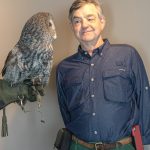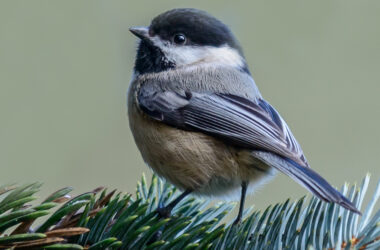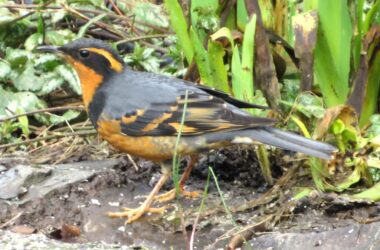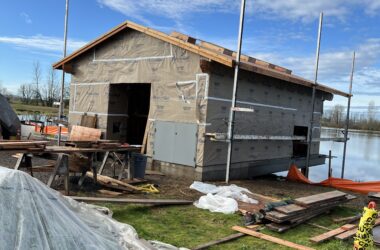My first experience with bird banding happened thirty years ago. A novice birder, I went to a banding station at Point Reyes, California. I left deeply impressed by both the birds, and the banders.
To see a bird weighing less than an ounce, maybe 5 inches long, at 3 feet distance. How can something that small be adept, complex and able to survive? Then I watched a bander holding a black-headed grosbeak in one hand while he measured, weighed and banded. The typical process.
As the name implies, the grosbeak has heavy mandibles, and sharp ones. The bird turned his head to get a good bite of the pointer finger on his prison and clamped down. While the bander worked, blood began to drip. Afterwards he gave us a shy grin: “I never like seeing those guys in the net.”
Net? Yes, before a bird can be banded, it must be caught and not hurt. I’ve spent several hours watching scientist Joan Hagar and her team at work. Each round of banding begins by retrieving birds caught in fine mesh called mist nets, strung out in the forest and thickets. I watched them at Luckiamute State Natural Area in northern Benton County. Hagar’s team visit nets every half hour. Each netted bird is carefully removed—preserving feathers, feet and wings. A bird showing high stress is simply released.
Each bird arrives at the banding station in a soft cloth bag. A bird in the dark is usually calmer. An actual small uniquely-numbered band is placed on one leg, like a small bracelet. But first, the bird is measured, weighed, examined for feather wear and general health. Accumulated from many individuals, the data provides solid information on population dynamics.
Joan Hagar is a research wildlife biologist at the Forest & Rangeland Ecosystem Center in Corvallis. It is a branch of the U.S. Geological Survey. Despite its name, the USGS began wildlife studies after it was founded in 1879. Hagar’s team has been working at Luckiamute for several seasons. They also banded at other Willamette Valley locations.
May 3 one year a Wilson’s Warbler was banded by Klamath Bird Observatory in southern Oregon. Two weeks later Joan’s team netted it at Snagboat Bend. A typical spring migration path.
One fall a white-crowned sparrow banded at Luckiamute turned up in Solano, California later that autumn. A Swainson’s thrush banded at Luckiamute one fall was netted in Lewis County, Washington two years later in mid-summer during breeding season. From such data points are likely migration patterns sorted out by scientists.
Though John James Audubon legendarily banded birds 200 years ago, the Smithsonian began organized banding in the U. S. with a 1902 project. In Oregon Klamath Bird Observatory and Oregon State University have offered training for would-be banders who must qualify for a federal permit. Don’t try this at home.
Read more about bird banding here.
For information about upcoming Salem Audubon programs and activities, see www.salemaudubon.org, or Salem Audubon’s Facebook page.
Harry Fuller is an Oregon birder and natural history author of “Freeway Birding.” He is a member of the Salem Audubon Society. Contact him at [email protected] or atowhee.blog. His “Some Fascinating Things About Birds” column appears regularly in Salem Reporter.
JUST THE FACTS, FOR SALEM – We report on your community with care and depth, fairness and accuracy. Get local news that matters to you. Subscribe to Salem Reporter. Click I want to subscribe!

Harry Fuller is an Oregon birder and natural history author of three books: “Freeway Birding,” "Great Gray Owls of California, Oregon and Washington," and "San Francisco's Natural History--Sand Dunes to Streetcars." He leads birding trips for the Malheur Field Station. He is a member of the Salem Audubon Society, and leads bird trips locally. Harry has just published a new book, BIrding Harney County.









